The First Edition
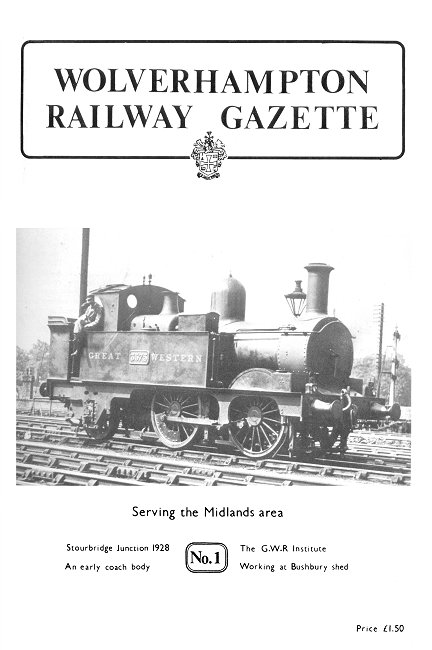 |
The magazine was launched in 1986 and the first edition
included articles on working at Bushbury Shed, an early coach body at
Oxley, Stourbridge Junction Station, Shrewsbury and Chester engines, the
Stafford Road Works Institute, the Low Level Station and the first part
of a compilation of principal events in Wolverhampton's railway history.
There were lots of illustrations including old photographs. Its now
interesting in hindsight, to read the article on Wolverhampton Low Level
Station, which at the time was about to be turned into a transport
museum. A project that sadly never materialised.
The cover photograph is of Great Western 3571 class,
0-4-2 tank engine, number 3575. The photograph was taken at Stourbridge
Junction. |
The G.W.R.
Institute
Social Life at Stafford Road Railway Works
| "The Institute" attached to the railway works at Stafford Road was
opened in 1855, modelled along similar lines to its older sister at
Swindon. Initially the membership stood at 140, all being men attached
to the railway works. From the beginning the railway company took an
active interest, Joseph Armstrong taking the presidents chair whenever
possible. Much of the money for such things as library books was
provided by individuals such as Sir Watkin, from within the company
itself. By 1859 the Institute library had 670 books with a monthly circulation
of 186. The reading room was supplied with 5 daily newspapers, 11 weekly
newspapers and periodicals, and 4 monthly journals. In 1858 the company
provided members with the first of what was to become an annual and ever
more popular event, when an excursion train filled with members and
their families set off for 3 days in Liverpool. In the same year a brass
band was formed, the Institute to provide the required musical
instruments, the teacher’s fees to be paid by the members themselves. At
the same time, a drawing class had begun under the expert direction of a
Mr. Bennett.
Also during 1858 the Institute council had provided an achromatic
microscope, a "large and powerful telescope", and a magic lantern.
"Stereoscopes have been placed in the reading room, and their varied
scenes have proved interesting and amusing". By 1860 chess,
draughts and a singing class had been added, and fourteen instruments
furnished for the band. A harmonium had been placed in the reading room,
a gymnasium and a "quiet" garden provided, which was well used during
the evenings that summer.
In December 1862 a new spacious building was erected, with gas lighting
laid on, at a cost of £100. This handsome structure lasted until the end
of the Stafford Road works in the 1960s. 800 people sat down to the
opening concert, frowned down upon by the life sized busts of Brunel and
Gooch, the walls being decorated with pictures showing the development
of the steam locomotive. Mr. Joseph Armstrong alluded to the wall
mounted locomotive views in his opening address, acknowledging Mr.
George Stephenson’s prowess in the spheres of engine design but adding
piously that the same gentleman was responsible for desecrating the
sabbath, running trains on Sundays. Everyone else had followed on from
his bad example being the moral of the story.
The next great occasion was the Royal marriage in
1863, when the Institute building flew flags of England, Denmark and
France from its flagstaffs, Mr. Fewtrill fired his cannon and 250
workmen sat down to a dinner at 1.00 p.m. inside the Institute.
Water only was provided "to meet the wishes of a number of workmen
who are advocates of the principal of total abstinence". After an
afternoon at the racecourse where festivities were laid on, the men
and their families enjoyed a tea and a ball, which did not break up
until after midnight. Mr. William Dean, then living in Alexandra
Road, Wolverhampton, gave the opening address, the newly formed
Institute Choral Society providing the music. By 1866, a bagatelle
room, had been added, and a "collection of microscopic objects".
Regular social functions had been instigated from the start, with
about five concerts occurring each year, and weekly meetings of the
various societies, the building being open each working day.
|
|
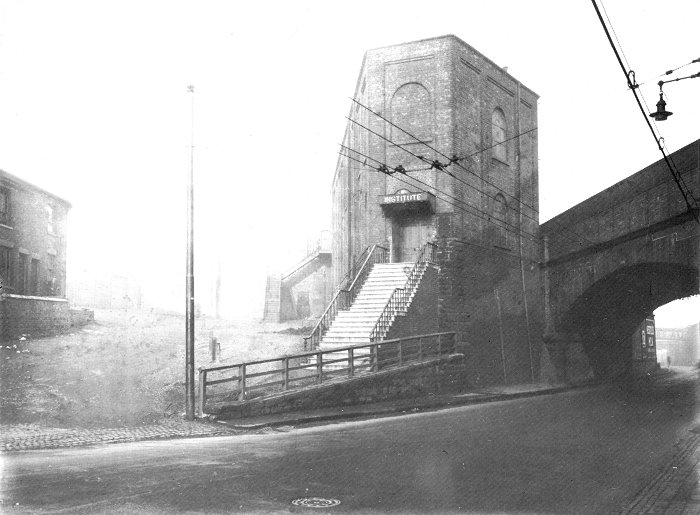
The entrance to the G.W.R. Institute as it
appeared on 20th January 1932, erected on the site of the former
toll house on the Stafford Road. The low bridge seen to the right
was replaced by a higher structure the following year, allowing the
double decker trolley buses a through passage. |
| By 1871 there was a "Mechanics Association", a cricket club and
fortnightly rather than monthly entertainments. In 1875 a large billiard
table was purchased and a recreation ground levelled and prepared in a
field lying between the canal and the branch railway leading from
Cannock Road Junction to Bushbury. Here a cricket pitch and a gymnasium
boasting "horizontal, parallel and leaping bars, double and single
trapeze, climbing poles and ladder swings etc." was erected. At one end
of the field a quantity of fish were put into the recently made Great
Western reservoir "so that angling may constitute a portion of the
recreation". A newly constituted band, complete with a distinctive
uniform was formed in 1876 and held a brass band competition at the
beautifully wooded grounds of Oxley Manor. Crowds of people lined the
Stafford Road to see the event and a jolly time was had by all, thanks
to the benevolence of the owner of land, the M.P. Alexander Staveley
Hill. After the prize giving, won by the "Kidsgrove Real
Excelsior Band" the entertainments went on into the evening with "Old
English pastimes", and dancing. |
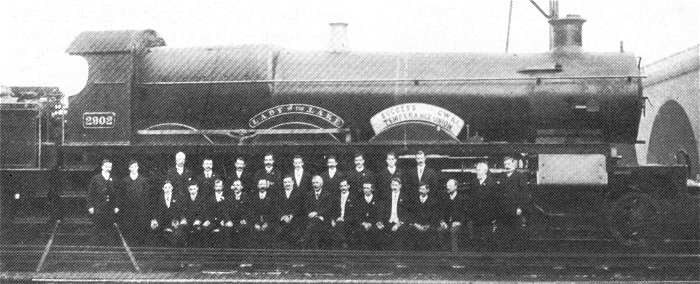
The officers and committee of the
Wolverhampton No. 1 branch of the G.W.R. Temperance Union in 1909.
In the background is number 7902 "Lady of the Lake" which hauled the
first non-stop train over the new Birmingham route. Photo: G.W.R.
Magazine. |
| In 1881 the membership stood at 870 but by 1885 the
membership was falling, the recreation ground had been given up, the
billiard and bagatelle room closed. The Junior Engineering Society
held talks on subjects such as "Joys valve gear as applied to Great
Eastern express engines". The Railway Servants Mission, presided
over by the L.N.W.R. stationmaster, Mr. Worth, held the excursions
for railway employees and their families were described by 1897 as
Wolverhampton’s largest excursion of the year". The trains started out from Low Level but most people joined them at
the newly opened Dunstall Park station. Over 2000 people took advantage
of the company trains to Birkenhead, Liverpool, North Wales, Manchester,
Worcester, Malvern and the Severn Valley line, Newport, Cardiff,
Swansea, Bristol, Western-Super-Mare, London and intermediate stations,
a far cry from that first trip in 1858! There were missions and tea
evenings which were attended by 100 men and their wives, but the
original enthusiasm seems to have dwindled. |
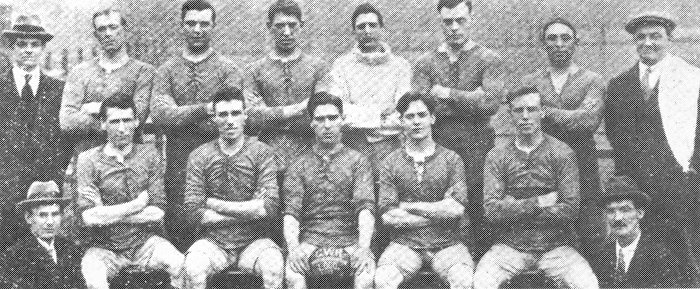
Stafford Road works football team from the
pages of the G.W.R. magazine. The club was started by the works
manager Charles Crump as early as 1876. When the team played the
"Walsall Swifts" at Foxes Lane in 1879 before a crowd of 2,000, the
Swifts complained that spectators had lined the goal area,
preventing the ball from scoring! Crump maintained an interest in
the club for the rest of his days. The team are shown here in the
1920s. Photo: G.W.R. Magazine. |
| In 1890, the Great Western Temperance Union began to
meet at the Institute, as did the Locomotive Steam Engineman’s
Improvement Class. The membership of the Temperance Union by 1895
stood at 1047 compared to 800 in the previous year, and at
Wolverhampton a Band of Hope was in a flourishing condition at the
Institute. A singing class was formed, and the Great Western Mission
set out from Stafford Road regularly with their accordion to visit
the lodging houses of the town.
Membership of the Institute fell in 190l due to 23 of its members
leaving for the war in Africa. The total of books in the library stood at 3,856, having remained at
this level for some years previously. Newspapers and periodicals were
still provided, the reading room was used for Sunday and week day
services by the Temperance Union and the Railway Mission, the Band of
Hope and Choral Union meetings using the room on Thursday evenings. This
obsession with sour faced Victorian religion seems to have had the
effect of driving many functions to more amiable surroundings. For
instance the Great Western Social evening in 1904 was held at the "Angel
Hotel" and attended by a "large number of the company's officials,
clerks, foremen, etc." Even J.A. Robinson himself attended! The new
century was bringing a wind of change in other ways too. |
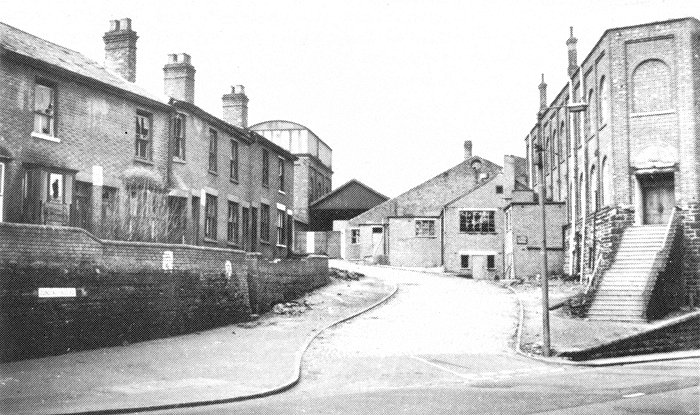
A view of the vehicular entrance to the
Stafford Road Works, with the Institute on the right, soon after
closure. The terraced houses, home to so many railwaymen, are also
empty and awaiting demolition.
Photograph John Bates. |
| At least one member of the Great Western Mission
abandoned the sing songs in the lodging houses, and the attempts to
raise the spiritual aspirations of the down and out. A.P. Mitchell
began to wonder if the cause of the problems could be tackled
instead, and joined the newly emerging Labour Party. Membership of
the Institute still stood at 1,102 in 1910 when "many worn out works
in the lending library have been replaced, as far as practicable, by
new copies". Billiard and Whist drives have been well attended. The
bowling played 26 matches and fishing competitions were held at
Bushbury Pool. For the second year in succession, gardening competitions had to be
abandoned owing to lack of entries, and neither boating nor swimming
found much favour. "A football club has been started, the first team
being affiliated to the Wolverhampton Friendly League". Activities at
the Institute ceased to find space in the newspapers from the First War
onwards, and by 1922 when the Great Western Temperance Union held its
annual meeting at Wolverhampton, thousands from all over the system
heard the speaker denounce the men of Wolverhampton for having so few as
176 abstainers in their ranks. The Institute still had an Orchestral
Society though, for they provided the music for the evenings
entertainment.
From the 1920s onwards the upsurge in other amusements, the cinema, the
radio, the dance halls took their toll of the working men’s
institutions, which were essentially a Victorian commodity. The football
club continued, appearing several times in the "Great Western Magazine",
the swimming pool at Showell Road remained popular, but the Institute
itself played less and less of a role in the lives of the men at the
works. The billiard room remained in use to the 1960s, the smaller rooms
were used for union meetings, but life had passed the Institute by. The
building was closed and demolished along with the works, which it had
served for over a hundred years. A section of the steep stairway that
once led up to the entrance is all that can be seen of the Institute
today.
|

|
|

|
|

|
| Return to
the Beginning |
|
Return to
the Exhibition |
|
Proceed to
Edition 2 |
|